
- Trips Formation Football (4 Best Plays Out of Trips)
By Coach Martin | Football Offense
- You are here:
- Football Offense
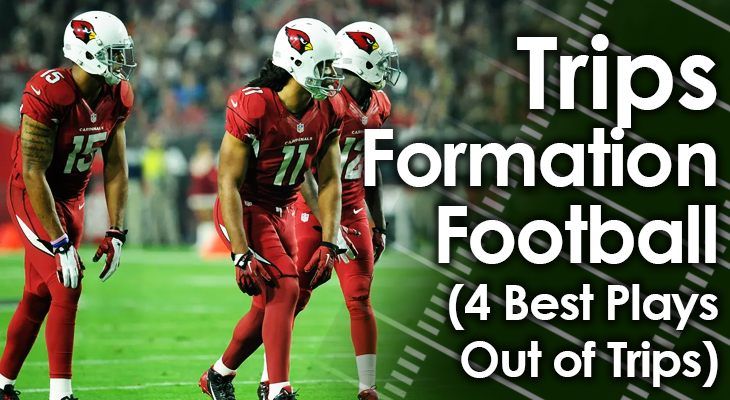
The Trips formation is one of the most popular formations in football.
A lot of teams use it in the modern game because it allows offenses to both spread the field and create confusion + chaos.
Below I'll explain what trips formation is, why it's so popular, and then we'll break down 4 of the best plays to run out of Trips formation.
Free Download:
"The Ultimate Guide to Football Defense" Booklet (254 pages)

What is Trips Formation?
Trips Formation has 3 wide receivers stacked on the same side of the field.
This can cause a lot of confusion for the opposition team.
Offenses can run it out of the shotgun formation or with the quarterback under center -- though most teams prefer to run it out of shotgun today.
In addition, most offenses will also have another wide receiver lined up to the opposite side of the formation all by himself. Doing so forces the defense to put at least one cornerback to that side of the field.
Why Trips Formation Works
Trips Formation is great at creating mismatches.
First, it forces the defense to either go with the Nickel formation , with five defensive backs on the field; or have a linebacker cover a receiver.
Next, it forces the defense to either:
1. Put four of those players to the side of the field with Trips -- which leaves the other receiver one-on-one.
2. Or put a safety over top of the lone receiver -- which puts all three receivers on the Trips side to be one-on-one.
And Trips can get even more confusing...
Well-designed plays have the receivers on the Trips side running in different directions, which forces the defenders to sometimes cross in front of each other.
It's easy for defenders to lose their man against Trips or to even bump into each other, creating plenty of open spaces for receivers.
Best Trips Formation Plays
Play #1: smash.
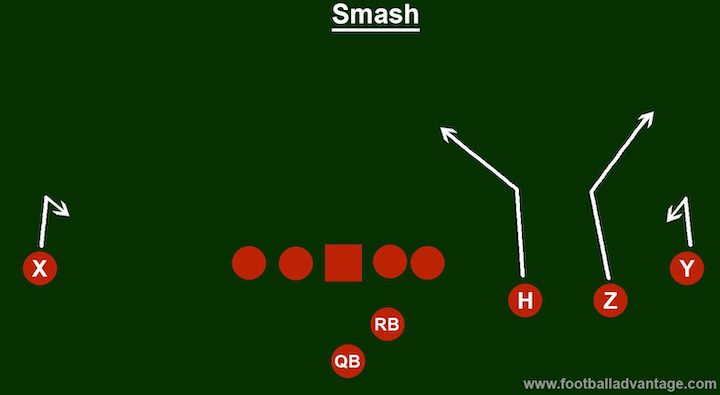
Smash is a play in which the two inside receivers will attack the deep part of the field, while the two outside receivers will run short routes.
This is a great play as it attacks the defense on multiple levels, and creates different looks on each side of the field.
Against zone, Smash usually sees the outside receivers having only one defender on them, with the safeties helping out on the deep routes.
This means that the outside receivers will have a lot of open space if they can shake that first defender.
On this play, the lone receiver on the left and the outside receiver on the right will run inside Hitch routes . The H will run a Deep Post toward the middle of the field, while the Z will run a Deep Corner toward the near sideline.
Play #2: Box

Box is a play that looks to cause confusion in the middle of the field.
By running three out of the four routes toward the middle, there will be many defenders running in front of each other and to the same place on the field.
It's easy for receivers to get lost among all these bodies, and then come out wide open as a result.
By having the two outside routes attack the deep area of the field, it leaves a lot of room for the underneath routes to run after the catch.
The X will run a Deep Post toward the middle of the field, while the Y will run a Go route down the right sideline.
The H will run a Shallow Drag from right to left, with the Z running a Dig/In route about 10 yards downfield.
Play #3: Skinny Post Attack
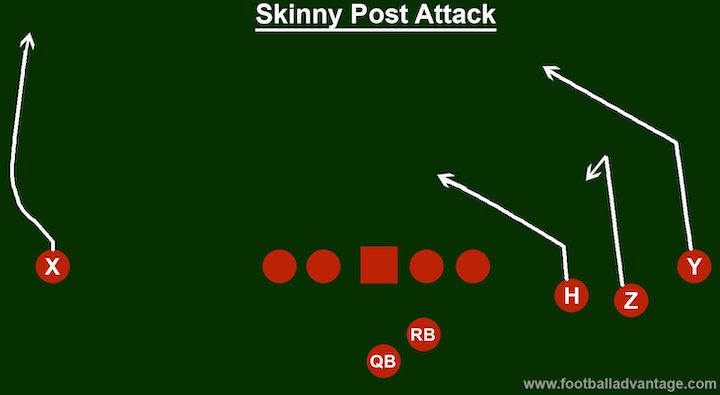
The Skinny Post Attack is great at attacking the defense at three different depths on the Trips side of the field -- all toward the middle of the field.
This often causes defenders to have to make a choice as to which receiver to cover -- especially the safeties .
Since the X on the outside will run a Deep Fade down the left sideline, he's often matched up one-on-one and could find himself free deep.
The X will run that Deep Fade down the left sideline.
On the Trips side, the H will run a Skinny Post , the Z will run a Deep Hitch, and the Y will run a Deep Post.
Play #4: Scissors
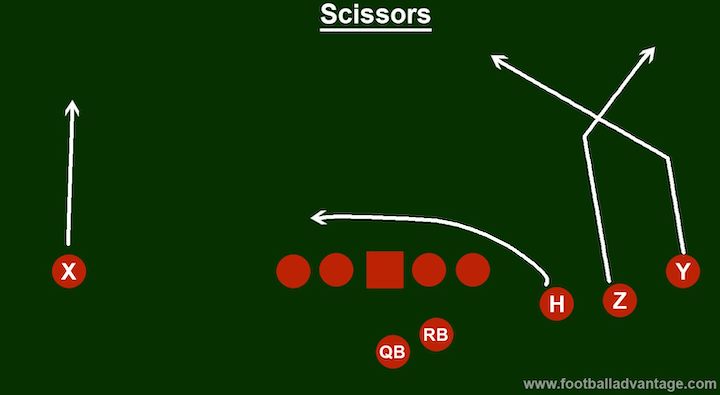
Scissors if the perfect example of how the Trips formation can use routes that cross each other to cause confusion.
In this play, the two receivers to the right in Trips will run mirroring routes that will cross each other at some point.
This will hopefully cause defenders to either run into each other, stumble trying to avoid each other, or just plain lose their coverage man.
Meanwhile, the two other receivers will run clear-out routes to take advantage of what should be a lot of free space.
The Y will run a Deep Post while the Z will run a Deep Corner .
The H will run a Shallow Drag while the X will run a straight Go route.
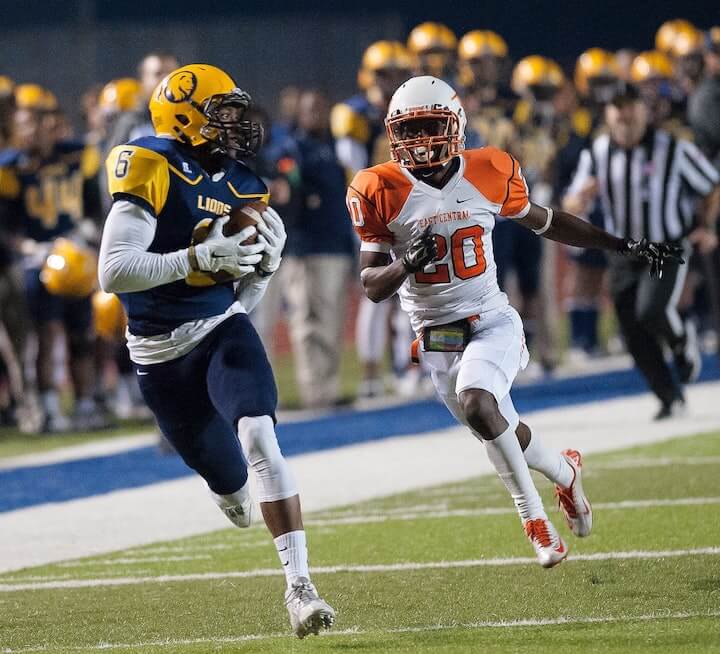
Many teams in today's game use the Trips formation, in some form, because of the many advantages it has.
While most offenses that use Trips will do so out of shotgun, it is a formation quarterbacks can use under center, too.
It causes a lot of confusion among the defense and creates great mismatches at just about every level.
What's more, it also helps to isolate one great receiver on your team, allowing him to often match up one-on-one against a defender.
Related Posts:
What is 21 Personnel in Football? (Full Explanation)
Singleback Formation (Coaching Guide With Images)
Pro Set Formation (Coaching Guide With Images)
Slot T Offense (Coaching Guide With Images)
Leave a Comment:
Save my name, email, and website in this browser for the next time I comment.
(0) comments
The ultimate guide to football defense, 15 fantastic defensive strategies (250 pages).
Enter your email below to get access for free:
100% Privacy Guarantee. Your email address is safe with me
Spread Offense 101
Home » Football Plays » Spread Offense 101
- Facebook 337
- Pinterest 2
- StumbleUpon
- Odnoklassniki
- ManageWP.org
- Facebook Messenger
- LiveJournal
The spread offense, or at least its core ideals, have been around in football for 50+ years. In today’s game, its most popular iteration is the shotgun spread. But whether it’s being run out of a Singleback formation, the Shotgun, or the new in between variant – the Pistol – it remains an effective offensive philosophy.
Spread Offense Formation
The idea is to spread the defense out horizontally, pulling off extra blockers, like the fullback, and putting in extra receivers. With the defense spread out, it is easier to isolate man coverage, as well as to find and throw to the holes in the zone. The same goes for the running game - with the defense spread out all over the line of scrimmage, it is much more difficult for them to stack the box and prepare for the run.
As far as personnel, you need a deep stable of pass catchers, as unless all the receivers are threats, the defense will have no need to spread out and defend them. You also need a quarterback with a good arm, and a running back who is adept at reading his blocks.
Another popular variation is the spread option. By combining the classic option and the spread principles, we give our quarterback a chance to run the option against a thinned out defense, with fewer defenders to contend with. That’s because when run correctly, the option is in effect blocking a defender for you, giving you an advantage at the point of attack without cluttering it up with extra players.
Spread Offense Plays

If you're interested in learning more about Spread Offense, make sure you check out our Spread Offense Playbook . It's packed with 10 simple, fun and effective plays designed for youth and high school football. All explained with player responsibilities, step by step diagrams, and implementation tips for coaches.
Below are some sample plays you can check out.
Running Play: Shotgun Spread - Inside Zone
Play Strategy
A classic play that has been growing in popularity recently, the inside zone run from the shotgun spreads the defense out and forces them to respect the pass, leaving fewer men in the box for you to run against. This is a great play on first and 10, with the threat of the pass leaving your running back in good position to set your team up for second down, or maybe even pick up another first.
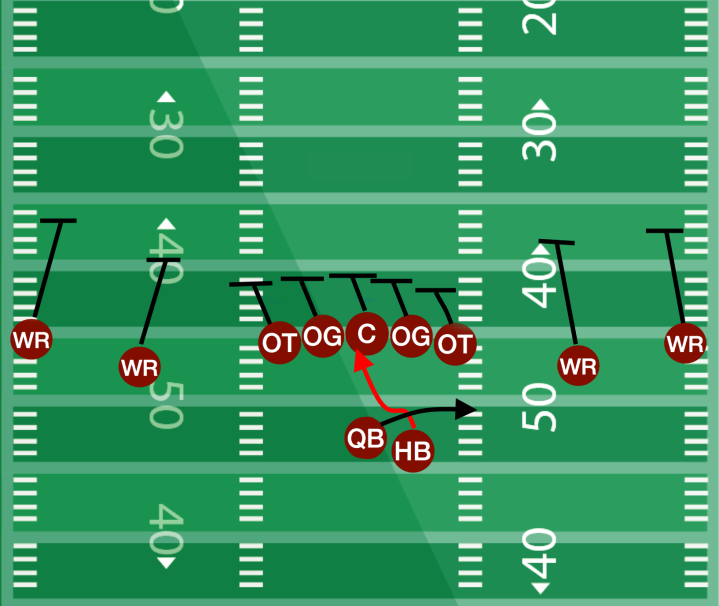
Positional Assignments
- Offensive Line - The zone blocking scheme on this play requires all offensive linemen to immediately take a step playside when the ball is snapped, moving downhill and blocking the first defender to come into their assigned zone.
- Wide Receivers - All four receivers will try to leverage inside of their corners, then block them to the outside, away from the play.
- Running Backs - The running back will step up, taking the snap from the quarterback and heading for the inside hip of the left guard. He will take his time, watching the play unfold and staying ready to continue flowing left, accelerate downhill, or cutback across to the backside.
- Quarterback - The quarterback will hand the ball off to the running back, then sell the quarterback keeper fake, running out to the backside of the play to keep the backside end occupied.
Passing Play: Shotgun Trips TE - HB Motion Verticals
When you need a completion for big yardage, this is a great play to pull out of the playbook. Ideally, you would call it when you can expect your quarterback to have plenty of time in the pocket and you need a big completion. The routes are all slower developing, and neither the halfback nor tight end stay in to block, so it’s important the quarterback has enough time to get the ball downfield for a big time throw and catch.
This is a great play to mix into your 2 minute offense, lulling the defense to sleep with short completions before exposing them on a deep pass for the big play.
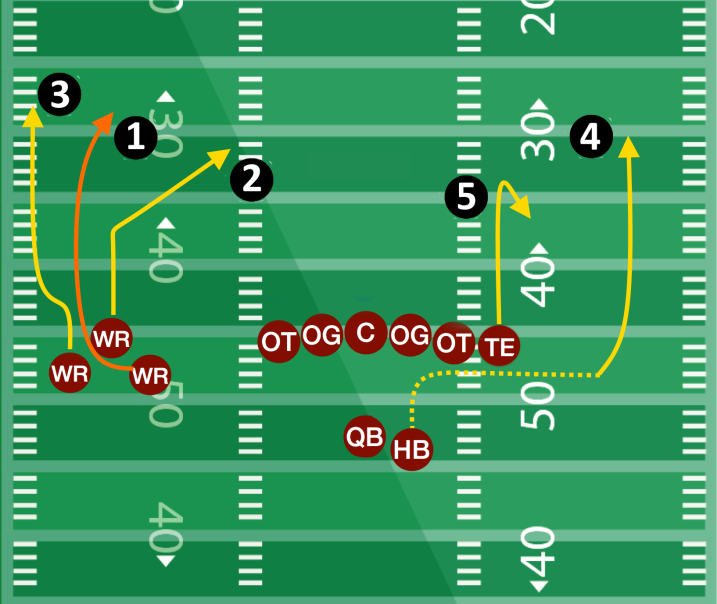
- Offensive Line - The offensive line will be in pass protection, giving the quarterback as much time in the pocket as possible.
- Tight End - The tight end will run a curl route here, ready for the quick pass in case of a blitz, as he is the quarterback’s hot read.
- Wide Receivers - All three bunched receivers will run deep routes. Going from left to right, the receivers will run a fade route, a post, and a wheel route, putting a ton of pressure deep on that side of the field.
- Running Backs - When the quarterback motions him out, the halfback will step up, and split out wide on the strong side. When the ball is snapped, he’ll run a fade, looking to take advantage of an overmatched linebacker if the defense is in man coverage.
- Quarterback - The quarterback will motion the halfback out wide, watching to see if a linebacker follows him out. If a linebacker does, and it’s a mismatch in your advantage, the running back should be your number one option on this play. Otherwise, your quarterback’s first option will be the slot receiver running the wheel route on the weak side. His second option is the split end running the post, and the third option is the flanker on the fade route. In the event of a blitz, the quarterback’s hot read is the tight end.
For more plays like this, check our complete Spread Offense Playbook today!
More Football Offenses
- I-Formation Offense : great for playing smash mouth football and overpowering the defense at the line
- Double Wing Offense : uses two wingbacks to set up power runs and misdirection plays
- Singleback Offense : a versatile passing offense, which also works well for draws and outside runs
- Pro Set Offense : provides excellent balance, allowing you to get the ball to any area of the field very quickly
- Wing-T Offense : an all-time favorite at the youth level, which emphasizes counters, reverses, bootlegs and short passing plays
Or, if you need help develop fundamental offensive skills, don't miss our drill collections covering quarterbacks , offensive line , running backs and receivers .
- Subscribe/Renew

- Athletic Administration
- Concussions
- Sports Medicine
- Strength & Conditioning
- Athletic Leader
- Glossary of Terms
- Track & Field
- TechTime Videos
- 2024 Coach & A.D. Buyers’ Guide
- 2024 Winning Football Playbook
- 2024 Winning Hoops Coaches Playbook
- 2023 Digital A.D. Toolkit
- 2023 Coach & A.D. Tech Guide
- *NEW* TechTime Videos
- Educational Webinars
- Exclusive Downloads
- Podcast Archive
Defending The Trips Formation
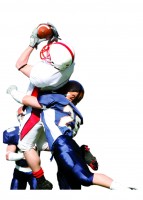
The top-tier teams in our conference all run versions of the spread offense. We utilize the 33 Stack defense and our coaching staff works hard on adjusting blitz concepts so as not to compromise our secondary coverages. Our “Buster” scheme, as we dubbed it, has been an integral part in defending against our spread opponents.
The Master Of Disguise One of the more popular spread-formation looks our opponents use is the Trips or 3-by-1 set. By having three receivers on one side — a wide receiver (WR) and two slot receivers, or, a WR off the line of scrimmage (LOS) with a slot receiver and a tight end — and a WR on the weak side, the offense creates an unbalanced-spread look, which challenges the defense to match up. When this occurs, the defense must account for three receivers on the strong side and the backside receiver, plus stopping the run.
The offense’s goal is to create misdirections to befuddle the defense. So, to counter this, your defense needs to disguise what it wants to accomplish — disguise a blitz or disguise the coverage.
The use of disguise in our Buster series is the solution to getting maximum coverage on the strong side, while preventing weak-side vulnerability — all the while serving a heavy dose of the blitz. Buster creates confusion and misreads by the QB. This leads to sacks, interceptions, fumbles, incompletions or stuffing runs.
Beating The Offense With ‘Buster’
Buster is an audible call out of our regular defense. The Buster audible series may appear complicated at first. When coaches break it down, however, it is easily taught. Our players have come to enjoy the problems Buster creates for opposing offenses. And, the “big play” opportunities for every defender on the field play an important role in the players learning their assignments.
One method we use is to “flop” our ends, spurs and outside linebackers (LB) in our 33 Stack defense. Aligned to the strong side are the defensive end (E in the diagrams), Sam Linebacker (SLB), and the Archer LB (a spur). Aligned on the weak side are the speed-end rusher (R), Will LB (WLB) and Lance (another spur).
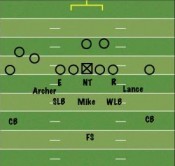
These movements now create a Cover 2 shell look for the QB’s read as he is in cadence.
The Archer stems, aligning with the No. 3 (inside slot) receiver. The Archer’s outside leg splits the No. 3 WR’s body.
The timing of the movement from what Diagram 1 shows to the look of Diagram 2 is determined by your coaches during game planning. From watching the opponent, here is a good rule of thumb: the moving defenders should watch the center.
Centers tend to look through their legs to get an accurate reference point of snapping the ball to the QB. Centers look up prior to snapping the ball. Between the initial QB cadence and the snap, the QB is seeing the defense shift into a Cover 2.
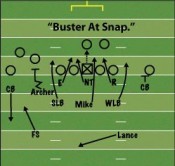
Defending Adjustments After you stuff the basic trips formation a few times, the offense typically smartens up and adds some adjustments to its look.
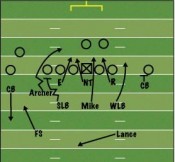
The speed option to the weak side is a popular running play for spread offenses and it is addressed within the Buster audible.
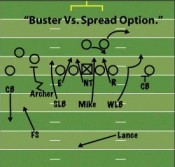
If the defense makes the “strength” call when the offense lines up in a 2-by-2 set, and when the offense motions to trips, the potential for confusion exists. To follow suit and audible to Buster would mean a wholesale shift of personnel from one side of the field to the other. To avoid such confusion, go with Buster Opp (see below).

At the snap, E takes an initial step toward to offensive tackle. He then backs off into flat coverage. The Archer LB has taken his outside pass rush with the SLB blitzing the B-gap. The defense is still rushing six, and it becomes a “cat-and-mouse” game with the QB — that’s why the zone blitz is named Minnie.
The “Cincy” audible (see below) out of Buster is a weak-side CB blitz and is a second option for your defense against the offense motioning out of Trips and into a 2-by-2 formation.

While the CB stems, the SLB and Mike LB stem to a 30 look; lining up 3 1/2 yards from the guards. The FS stems to a 1-by-7 look on the strong side. On the snap, the nose tackle (NT) stunts to the weak-side B-gap. The SLB and Mike LB blitz the A-gaps.
A delay blitz by the Mike LB may work best, depending on the direction the center takes. The WLB takes the flat coverage to look for the ‘hot’ route. The Lance covers the weak-side receiver deep, with the FS jumping the “hot” route by the strong-side slot or wide out.
For the empty formation (3-by-2 look with only the QB in the backfield), make a minor tweak.
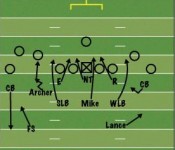
You Might Also Like

One thought on “Defending The Trips Formation”
Here is a link which provides video of Buster. https://www.youtube.com/watch?v=gsmh6gRCbKQ
Leave a Reply Cancel reply
You must be logged in to post a comment.
Latest News
Md athletic director used ai to frame principal with racist remarks, nfhs approve 6 rule changes for high school wrestling.
More News »
Popular Now
- Merrimack removes lacrosse player for racist remark April 25, 2024
- 10 must-read books for coaches & athletic directors December 21, 2023
- Study: Parents’ sideline behavior greatly… April 16, 2024
- OSAA defends gender policy regarding trans student-athletes April 23, 2024
- Coaches notice changes throughout youth sports landscape April 23, 2024

Measuring the success of your athletic program
coachad.com
Share on Facebook Share on Twitter Share on Linked In Share by Email
[email protected]
(616) 520-2137
- Update Your Subscription Address
- Editorial Submissions
- Privacy Policy
- Cookie Policy
- Terms of Use
- Do not sell or share my personal information

Subscribe Now!
- Cross country
- Sports 40 Under 40 Awards

7 Best Quick Pass Concepts
If you’re a coach that has a “take what they give me” mentality, then there is a good chance that your quick pass concepts will be some of the best pass game concepts that you have. In my opinion, not enough coaches invest enough time into their quick pass concepts, and it shows during the game. Too many times coaches are trying to force the ball down field rather than attack open space that is available right in front of them. This leads to frustration in coaches because the QB is completing a low percentage of throws, the offense is struggling to get anything going, and drives are resulting in punts rather than touchdowns. If coaches would commit to their quick pass game then they’d realize that it’s easier to complete passes, establish tempo, and sustain drives that lead to touchdowns.
I love a good quick pass game because it’s a great way to quickly attack the defense. This quick attack will help relieve OL who are struggling to pass protect and will counter a blitzing defense as the QB will immediately get rid of the ball before feeling any pressure. For us, it’s an extension of the run game as we emphasis that our quick pass has to be as good as a hand off. Our goal is to always get five yards. With a successful quick pass game, the defense will have to react quickly to the point of attack by pursuing the football and making an open field tackle, something many high school defenders struggle with. Sometimes all it takes is a simple 5 yard throw to get you the big explosive play you’re looking for.
Here are seven best quick pass concepts that will lead to more completions, first downs, and touchdowns.
7 Quick Pass Concepts

Bubble is the first quick pass concept that gets installed in my offense. I will start in a 2×2 formation and then get into a 3×1 formation to throw bubble . This is a great way to get the ball to the speedy and shifty WRs in the slots. It’s best to throw it against a 2 high structure and to the side that the Corner is giving the most cushion. The #1 WR will stalk block the Corner which leaves the slot WR in a 1on1 situation with the Safety or OLB. In order for this play to work WR’s must be 100% committed to blocking on the perimeter.
Below are just a few variations of throwing bubble out of 3×1.

In the last image there is a slight change to the blocking responsibilities of the other two receivers. This cross block is great against quarters teams that put the OLB outside shade of #2 WR. Instead of trying to get your #2 WR to his outside pad, which can be very difficult since he’s already out leveraged, have your #1 WR cross block on the OLB and send the #2 underneath to block the CB.

Quick is another great concept that can also be ran out of 2×2 and 3×1 formation. Bubble and Quick go hand-in-hand for me and we install these plays together. This can be helpful when preaching the importance of blocking on the perimeter because the WR group starts to see that everyone needs to block for each other for these plays to work.
Like Bubble, Quick is a great concept out of 3×1 formations. Below are a few variations of that.

Note the blocking responsibilities are slightly different when running Quick out of a bunch 3×1 formation. This is when the defense will take their OLB and put him on or press the point in the bunch set. The emphasis in blocking Bubbles and Quicks is blocking the most dangerous defender, so we don’t want our #2 WR to immediately take off for the CB and leave the OLB free. We coach this block similar to how our OL block outside zone . We want our #2 WR to have his backside hand through the sternum of the OLB and his right hand on his outside pad; trying to turn him inside. The #3 WR must immediately work to take over the OLB so the #2 WR can climb for the CB. This is a very quick combination and is best when the OLB is pressing the point and the CB is off.

All hitches are an important part of the quick pass game because it can be one of the easier throws for a QB to make. The QB can see the whole chest of the WR and doesn’t necessarily have to hit a moving target. It’s a simple pre-snap read for the QB who is picking a side to throw the football based on the depth of CBs and alignment of apex defenders.
Against single high safety teams, the ball should go to the outside WRs and to the side where the CB is giving the most cushion. Against a two high safety defense the ball can go to the WR in the slot that doesn’t have an apex defender to his side (assuming defense keeps a 6 man box), or to the outside WR with a CB that is giving the most cushion.
All hitches is one of the quick pass concepts that I will tag with run game because it’s a very quick and simple pre-snap read for the QB to determine to throw the football or go with the called run play. This is a great way to take advantage of teams that try to either load the box to defend the run, or empty the box to put guys in coverage.
Slant – Arrow

Slant arrow is a great concept against a single high safety team that will play with two apex (OLB) defenders. This concept is a simple defender key read which is on the OLB’s. The QB will make a decision on which side to throw the ball based on a pre snap read of the depths of corners and alignment of apex defenders. The post snap read for the QB becomes the OLB. If he runs to the flat with the arrow route, then the QB will throw the 3 step slant behind him. If he’s late getting to the flats and the slot has the OLB out leveraged, then the QB will throw the ball to the arrow route into the flat.
Fade – Out

One of my favorite quick pass concepts is the fade-out. It can be thrown against a single high safety or a two high safety look. Single high safety is preferred because the concept is simply putting a high/low on the vertical defender, which is the CB in a single high safety look. The QB will pick a side to throw based on pre snap read of the depths of CB’s and alignment of apex defender.
If one CB happens to play with less cushion (under 7 yards) from the LOS, then the QB can catch and throw the fade route. If the CB’s are playing with cushion (above 7 yards) then he should pick a side based on which slot WR has better leverage on their apex defender. With the vertical fade route taking out a cover 3 corner, the flat space becomes open for the 5 yard speed out from the slot.

The variation of stick that you see here is probably different than how most coaches are running stick. It’s not a true stick route where the #3 WR will turn to the outside and work away from the Mike linebacker. In this stick concept , it comes out of 3×1 formation and the #1 WR is running a go route, the #2 WR is running a 6 yard hitch and the #3 WR is running a bubble. On the backside the single WR is running a 3 step slant, unless tagged otherwise. The defender that is put in conflict now is the OLB. The read for the QB is simple. If the OLB takes the bubble in the flat, then throw the hitch behind him. If the OLB sits on the Hitch and bubble has him out leveraged, throw the bubble. The go and backside slant are pre snap reads for the QB. If the corner is under 7 yards, and the QB likes the matchup, he can catch and throw the go route. If the defense floods to trips and leaves the backside slant, then he can catch and throw the slant.
Out – Stick

The out-stick combination is a great concept against single high and two high safety teams. This is a great concept to attack the outside flats against a cover 3 teams that have their Corners play off. If a team jumps into a 2 high structure and still leaves 6 in the box, then one slot is left open with a LB in the box trying to play in coverage but still defend the run. The stick route is a great option as the route works away from the near linebacker in the box.
The outside WR’s need to reduce the splits and they are rolling over their outside hip (speed cut) and getting to 5 yards on their route. The slots are running 6 yard stick routes where they will turn to the outside and work away from coverage.
Using Quick Pass Concepts to Set Up Vertical Shots
This is where the “take what they give me” mentality benefits an offensive coordinator. Most DC’s will give up routes under 5 yards and tell their players to rally to the football. If I know a DC is willing to give up 5 yards then I’m going to quick game them to death. When an offense can successfully complete their quick game pass concepts, then defenses start to tighten up and their instincts start to kick in sooner as they are downhill in a hurry.
Below are a few examples of how you can use quick pass concepts to set up vertical shots
Bubble and Go

Bubble and Go is a great compliment after successfully completing a few bubble routes. The key to knowing when to throw the Bubble and Go is identifying the safety and how he is reacting to the bubble route post snap. If the safety becomes a quick trigger on bubble, then it’s time set him up with Bubble and Go. This also works great against single high safety with a Corner who may play with the same tendencies. This can be ran out of 3×1 or in a mirrored 2×2 formation.
Quick and Go

Quick and Go is similar to Bubble and Go, but now this is intended to attack aggressive Corners who are quick to trigger on anything in front of them in the flats. If you have a Corner that is aggressive to make a play on Quick, then it’s time for Quick and Go to get that explosive play. WR must sell the stalk block in order to trigger the Corner into biting on the Quick. This can be ran in a 3×1 formation or in a mirrored 2×2 formation.
Stick and Go

Stick and Go is a great concept to attack Quarters coverage. When running stick you want to key on the safety and see how aggressive he is on the hitch route. The OLB should continue to carry the bubble into the flat, and the Safety may start creeping down early, or will be quick to trigger on the hitch route as he is the one responsible for making that tackle. Once you see the Safety start to play tighter to the line of scrimmage, or is quick to trigger on the the break of the hitch, then you have successfully used stick to set up stick and go.
This will be more of a shot play as the QB will hope to hit the stick-and-go no matter what. The important piece to making this play work is the bubble running hard to bring the OLB out, and for the slot WR to sell the hitch by sinking his hips at the 6 yard break point and turning his shoulders & hips to the QB as if he is really running a hitch. The patience in running the hitch is what will quick trigger the safety down. If the WR hurries through the hitch and doesn’t sell it well enough, then the Safety won’t take the bait.
Easy Quick Pass Concepts
These quick pass concepts are enough to attack multiple coverages, whether it’s man or zone coverage. Like anything, they must be repped every single day to build chemistry between the QB and WR group. Each rep must be ran at game speed to get a feel for the timing it takes make accurate throws and complete passes. Staying committed to the quick pass game and having the mentality of “taking what the defense gives you” can really frustrate a defensive coordinator. That’s because quick pass game can be used anywhere on the field and on any down, even on 3rd and 7. With these 7 quick pass concepts in your playbook, you’ll be able to put drives together that result in touchdowns.
- Football Plays
- Football Strategies
- Madden Tips
- Madden Playbooks
- Madden Guides

Common Pass Routes and Route Combos
In the article we posted on X’s O’s Football called " Passing Routes 101 " we broke down several passing routes for runningback, receivers, and tight ends. For this article we show several common pass routes and route combos that you will find in real football and video game football. We break the sections down with quick pass, medium pass, and deep pass.
A look at common quick pass routes, passing concepts, and route combos.

Medium Pass
A look at common medium pass routes, passing concepts, and route combos.
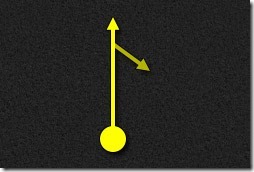
Double Moves

Shallow Cross
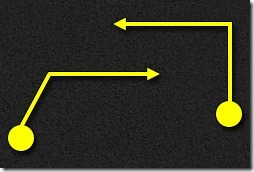
A look at common deep pass routes, passing concepts, and route combos.
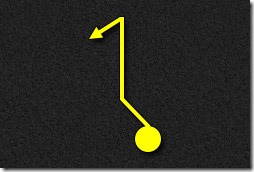
The comeback has the receiver taking an outside release and running about 18-20 yards up the field. He then break outside towards the sideline at a 45 degree angle.
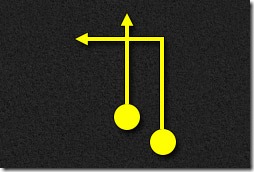
The Dagger is a two receiver route combo that has the outside receiver running a dig route, while the inside receiver next to him runs a streak down the seam.
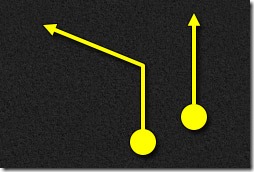
The Divide is a passing route that that has a receiver running towards the middle of the field. The route involves a MOFO or MOFC read by the quarterback. For those that don’t know MOFO simply means "middle of the field open," or no deep middle safety. MOFC means "middle of the field closed," or is there a deep middle guy. Another route is used to compliment the Divide pass route is a receiver on the outside running a go or streak route.
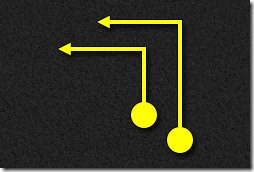
The Double Dig has two receivers running dig routes to the same side of the field. One receiver runs a shorter dig, while other receiver runs a deeper dig.
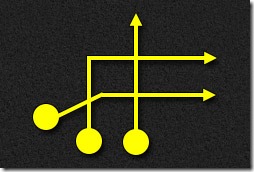
A popular way offenses like to attack zone coverage is flood one side of the field with mutiple receivers. The Flood concept does this by having three receiver running pass routes towards the same of the field. A common Flood concept would be to have one receiver run a flat, second receiver runs a deep out, and the third runs a go route such as shown in the diagram above.
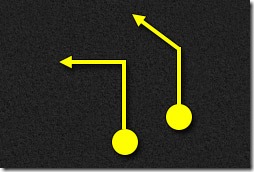
The Mills (Anchor) passing concept is designed to get a to bite on the dig route, allowing for the receiver running the post to get behind him for big play. If the safety does not bite on the dig route, then quarterback would look to throw to that receiver underneath.
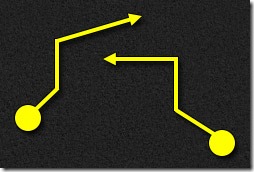
The Portland passing concept is similar to the Mills concept as the design is to provide an opportunity for the quarterback to look throw deep down the field to a receiver running a deep post if the safety comes up defend the dig route that is being run from the opposite side.
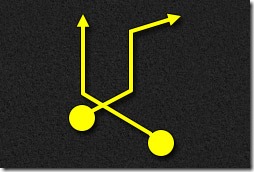
The Switch concept is a popular Run-&-Shoot passing concept that has outside receiver running a post route with an inside receiver. The inside receiver, runs a wheel route down the sideline. By them switching, it creates an opportunity for a big play deep down the field.
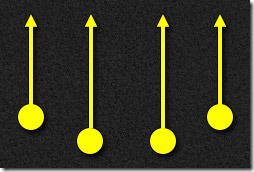
The Verticals passing concept sends 3 or 4 receivers on vertical passing routes. The idea behind this passing concept is to create either 3 on 2 or 4 on 3 against zone coverage, allowing for one of the receivers to be open deep down the field.
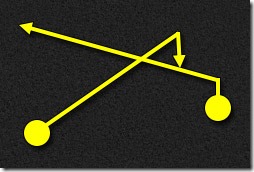
The Y Cross has the tight end (Y) running an intermediate crossing route. The concept is good versus both man coverage and zone coverage. If man coverage is called, the tight end will generally matched up against slower linebacker or a smaller defensive back. Once gains separation or leverage he is will be open. Against zone coverage, look for the tight end to be open as he crossing the field, especially if another receiver is running pass route underneath or over the top of him.
Final Thoughts
Hopefully this will give you better idea of common pass routes and route combos found in real football and football video games. Feel free to use this page as quick reference if you are confused about these type pass combos, pass concept, and pass routes are designed for.
RELATED ARTICLES MORE FROM AUTHOR
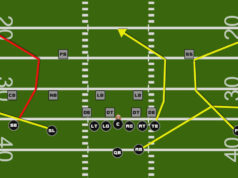
Post Corner High-Low Isolation Vs Cover 2 Zone Coverage
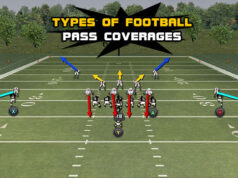
Types of Football Pass Coverages
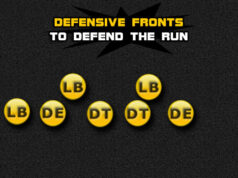
Defensive Fronts to Defend the Run
Who needs this… Football Nerds
Outstanding breakdown. These indeed are the most common route combinations and concepts. They pay Tony Romo about 17 million dollars a year to tell you this on Sunday, and Thursday Nights. Knowledge is power.
Okay but I think Romo may have a bit more knowledge than a few route concepts. He gives us top analysis through his experience of being a franchise quarterback, and happens to be an entertaining voice, name another announcer who can do that. Romo will turn out to be an all time announcer for CBS
LEAVE A REPLY Cancel reply
Save my name, email, and website in this browser for the next time I comment.
MORE MADDEN TIPS
Gun trips te – hb angle, backwards c route, 3-4 bear – pinch 0, the importance of madden sliders.

EVEN MORE NEWS

Gun Bunch Wk – Flood

Gun Doubles HB Strong – Y Cross

Gun Trips Left Hb Strong – S Motion Z Post
Popular category.
- Madden Tips 224
- Football Strategies 100
- Football Plays 77
- Kobra's Corner 26
- Digital Guides 10
Fundamental Pass Concepts
Two-man pass concepts.
These are some of the most common two man and three man pass concepts. This is not a definitive list, but a list of most common passing concepts that I've seen or ran at some point. These concepts are so common because they work. I've left out some of the Air Raid concepts because I have a separate breakdown here . Some of the specific terminology is omitted because there are multiple names for the concept across different coaches and systems. I also think that coaches get hung up on terminology too often. Call it something you and your kids will remember. This will be updated as time goes on.
🚨WORK IN PROGRESS🚨
Slant Flat "Dragon"
Double Slant
Curl Flat "Hank"
Deep Out "Hawk"
Seam Curl "Hoss"
Slot Fade "66"
"Mills"
Three-Man Pass concepts
Flood 2x2 "Sail"
Flood 3x1 "Sail"
Full Field Concepts
Full field Concepts, such as Mesh, Y-Cross and Shallow can be found in the AIR RAID breakdown.
Hoss Y Juke
Hoss Y-Juke is a great play out of empty to take advantage of split field coverage's. One of the weaknesses in a split field coverage vs. empty is that the Mike linebacker will usually matched up on the #3 receiver to the strong side. This concept relies on the quickness of the #3 receiver to win that match up every time.
X: Hitch vs. soft coverage. Fade vs Press.
F: Seam route, look for grass.
Y: Juke route. Sit if LB moves or doesn't match up with you. Whip if LB is in man or wall off inside. Run if LB plays head up or open grass in the middle of the field.
H: Seam route, look for grass.
Z: Hitch vs. soft coverage. Fade vs Press.
QB: Against 2 high safeties read the Juke. Against 1 high read hitch to seam on the side with the best leverage. Look for pressed corners and grass.
Bill O'Brien Hoss Y- Juke Patriots
Noah Riley Hoss Y-Juke Cutups
Yankee is a deep cross concept that is a great way to attack single high safeties. This concept is usually run out of heavy formations so the defense has to commit multiple defenders to the run. Most teams will run this a s a play-action concept with a 7+ man protection. This play is great if you have fast receivers on your team to get to the deep throw quicker. There are multiple variation of the Yankee concept, but the hallmarks of the play remain the same. A deep cross with a post.
X: Inside release. Break at 15 yards. Look for grass.
F: Check release.
Y: 5-6 yard drag.
H: Pass protect.
Z: Inside release. Break to post at 15 yards. Look for grass.
Saints "Yankee" Vs. Tampa Bay
Arizona "Yankee" Vs. Wash.
Dagger is a concept that is commonly used in high school, college and the NFL. It involves a vertical route by the slot receiver a deep dig from the outside receiver and a drag from a backside receiver. This stretches the defense vertically and horizontally and put pressure on a deep safety to make a play.
X: Inside release. Deep Dig. Break at 15 yards and look for grass.
H: Seam. Must get vertical to occupy as many deep defenders as possible.
F: Check release backside.
Z: 12-15 yard deep comeback. Can continue route vertical against man coverage.
QB: Read Dig - Shallow but peek at the Seam. Dig is the most likely to be open but peek at the seam to get a cheap quick shot down the field.
This play can be run a variety of ways and out of multiple formations. Tweak this to your personnel and game plan.
Bills "Dagger" Vs. Saints
Eagles 3x1 "Dagger"
This concept is a variation of shallow that is quick and easy to install in any offense. It can be run out of multiple formations and can be tweaked to fit personnel easily. The hallmarks of the Drive concept is a same side shallow and dig combination. This is usually paired with a post or seam route over the top of the play.
X: Outside release, get vertical.
H: Post route. Break at 10-12 yards. Can adjust to a skinny post or seam against one high defenses.
Y: 10-12 yard Dig. Outside release on the snap.
Z: Tight split to the Y. Run the shallow route at the heels of the DL. Must scream to the sideline and not stop their route.
QB: Read the Mike. If he comes up on the shallow throw the dig and if he drops throw the shallow. Peek at the post. F is checkdown.
There are multiple ways to run this play, too many to count. This is an effective way to attack the middle of the field, and its usually a pretty easy throw for the QB.
Arkansas 2010 "Drive"
"Drive" w/ "Mills" from 3x1
Cookie banner
We use cookies and other tracking technologies to improve your browsing experience on our site, show personalized content and targeted ads, analyze site traffic, and understand where our audiences come from. To learn more or opt-out, read our Cookie Policy . Please also read our Privacy Notice and Terms of Use , which became effective December 20, 2019.
By choosing I Accept , you consent to our use of cookies and other tracking technologies.

Acme Packing Company, a Green Bay Packers community
The dirty little secret about the trips formation - and one way the Packers take advantage
By AlexJKirby on Jun 28, 2016, 8:35pm CDT 5

Get the latest Green Bay Packers news with Acme Packing Company:

Here's the thing about the passing game: Even when you've got an incredibly accurate passer with a quick release like Aaron Rodgers , you'd still prefer to avoid risky throws whenever you can.
It doesn't matter how many books you read on the topic of how to coach quarterbacks , a recurring theme in all schools of coaching is the importance of limiting the amount of time the football is in the air.
For one thing, the longer the ball floats up there, the more opportunity the defense has to snatch it away, so the distance of the throw, as well as the defensive picture around the intended receiver, are all taken into account.
So enough with the tease, what does any of this have to do with that click-baity title I got you here with?
Do you want to know what that "dirty little secret" is about the Trips formation?
Here it is:
The Z receiver almost never gets the ball
It's true, I swear.
You probably think I'm full of crap, but remember this the next time you're watching a football game and the offense lines up in this set.
(If you're the gambling type, you can probably win a few bar bets this way)
I just spent the past few paragraphs talking about spacing, the distance of the throw, and the time the ball spends in the air.
These are all reasons why the Z receiver in the Trips formation actually doesn't get the ball thrown his way a whole lot.
Allow me to make my case in visual form.

You may not believe it, but that extra half second in the air makes a big difference, and a good coach is like an accountant, hard at work trying to eliminate excess waste and risk in the game plan wherever he can.
Examine most modern passing attacks, at all levels, and you'll find that most of the time, the Z receiver is used as a decoy, a distraction, a way to clear out the coverage for one of the other two receivers.
The Y Stick concept is a great example of this. The Z receiver goes deep and the two interior receivers work to get open underneath.
A lot of coaches are split on the topic of tendencies, and staying predictable. Still, everyone agrees that you need the ability to keep your opponent off-balance, even if your scheme doesn't feature a ton of bells and whistles.
So how do you get the football to your widest receiver in the formation, the guy furthest away to the strong side?
All kinds of ways, really, but in this post we're gonna be looking at one play call I thought was very creative.
The Packers receivers have a very good understanding of where they are on the field, how they fit in with the other pieces in the offense, and when the football is supposed to come out of the quarterback's hands.
This concept is designed with all that in mind, as well as the particular style of defense they're expecting to see.
When you're playing a team who specializes in zone coverage, or maybe you're just facing a long yardage situation, it's not enough anymore to simply drop back, invite the pass rush up the field, and then dump it off to the tailback behind a wall of blockers.
Defenses have gotten smarter, and even the ones who haven't have still gotten faster. It doesn't matter how well you fool a guy with that perfectly-timed screen pass if he has the speed to chase you down from behind.
So what's to be done? Well, you've gotta find other ways to get the football to your speedsters with blockers in front, and Green Bay has done just that.
Look at the diagram below.
You've got a corner route by the tight end, a very shallow slant by the Z receiver, and the slot receiver is blocking the guy across from him (we'll get to that in a second).

The tight end's route is timed up to break to the corner once he's passed the alley defender in the flat, and he'll immediately look to his outside shoulder.
As for the Z, he'll burst aggressively off the line of scrimmage and pivot on a sharp angle to get underneath the block of the slot receiver.
The block of the slot receiver? How do they get away with that?
I've written other places about how Green Bay's timed passing attack allows their receivers to be more aggressive when blocking for a quick screen, so I won't go into too much detail here. Still it's important to emphasize that the block itself isn't as important as the ability to get to his assigned depth in a hurry, and establish himself in that spot so he can avoid drawing an offensive pass interference penalty .
The ball should be coming out in a hurry regardless, and by the time he makes contact with the defender the Z receiver should already have the football in his hands and be trying to turn up the field.
The corner route by the tight end is designed to provide another option in the passing game if the defense clamps down, but also to clear the coverage in the middle of the formation and open things up for the Z receiver once he brings in the football.
Against a soft zone coverage, it's like stealing.
For as productive and exciting as this offense has been for so long now, it's amazing how little people have focused on the design and creative genius behind Green Bay's attack.
Mike McCarthy isn't really interested in being known as an offensive guru, so long as Green Bay keeps finding ways to win games. He knows what all good coaches know, which is that without a proper focus on the fundamentals , you won't get very far.
That said, it helps to have a great plan, and having little wrinkles like this one for common situations only makes the unit stronger as a whole.
What will they think of next?

More from Acme Packing Company
- Black and Blue News: This Week in the NFC North for July 6, 2014
- Cheese Curds: Green Bay Packers News and Links for July 7, 2014
- Packers 2013 Top Plays Recap: Top Ten Best Plays of the Year
- Packers Featured Heavily in NFL's Top 20 Games of 2013
- Packers' 2014 Roster Preview: Returning Quarterbacks
- Packers' 90-Man Roster Countdown: Players 5-1

Recent FanPosts
- APC Podcasts - New Home
- Mock Draft Open Thread
In This FanPost
- Green Bay Packers
- Aaron Rodgers (QB-GB)
Trending Discussions
- Friday Cheese Curds: Packers kick off on-field work with rookie minicamp
- Packers decline CB Eric Stokes’ 5th-year option
- Packers Film Room: Examining 1st-round pick Jordan Morgan
- Packers Reacts Survey: Did the Packers win or lose in the 2024 NFL Draft?
- Thursday Cheese Curds: Decision time on Eric Stokes’ 5th-year option has arrived
- Former Packers WR Davante Adams talks Jordan Love, trade to Raiders
- Packers News: Former USFL MVP Alex McGough moves to receiver
- Packers’ 2024 draft class receives their jersey numbers
- Wednesday Cheese Curds: Jeff Hafley gives Packers defense a fresh start
- No NFL team has made more draft picks than the Packers since 2022
Best Flag Football Plays
Formation: trips, plays out of the trips formation.

- Next Page »

Random Play Best Plays
Browse Plays
- Plays by Distance
- Plays by Formation
- Plays by Routes
- Defense by Formation
- Defense by Type
- Defense by Style
- The Playbook
- Playbook Maker
- Playbook on Amazon
- Dillon Hess
- Random Play
Copyright © 2023 bestflagfootballplays.com

Don't miss out on any of the Best Plays for Flag Football
Get the Playbook now and propel your team to Victory!
View Details Get Book Now

Bunch Passing Plays
I’ve got a confession to make. I love stealing formations I see on Saturday and making them my own. It makes me feel like I’m a hip, cool football coach, and that I’m on the cutting edge of the game .
I know, I need professional help.
But what formation have I stolen and used so much that it is slowly becoming a main part of my offense?
The Spread Bunch Formation.
Why do I love the Spread Bunch Form Formation?
- It looks cool as hell.
- It makes me seem as if I am on the cutting edge of football.
- My players feel badass when they line up in the formation.
- I can run every play out of the formation and nothing changes for my guys.
- It messes up defensive reads so bad that someone is always wide open.
How We Line Up in the Spread Bunch Formation
I know I’m not the only one here that uses the Spread Bunch Formation. Every team in America uses some form of it. I know of coaches that use it with a Full Back, Tight-End, and Flanker. And that’s cool.
But that’s not the way I use the Spread Bunch Formation. I use it with our 4 wide receiver set. We place the Y on the ball, the F on the inside, and the R/L on the outside.
Because everything we do offensively is built around hot, sexy, steamy SPEED. So all we do is tag Bunch to our Trio and BOOM – we have Trio Bunch. Simple enough.
What Plays We Run From the Spread Bunch Formation.
We can run any of our plays out of the Spread Bunch Formation , but I’ve found these three plays are our bread and butter out of the Spread Bunch Formation:
- Fast Screen
Fast Screen From Spread Bunch Formation
The first play we install in the Spread Bunch Formation is our quick screen to the number one receiver. We install this play first because we’ve found that teams like to play their corner eight yards off and to the outside of the Bunch.
This is freaking stupid because it is giving us a two on one advantage over the defense. But I’m not going to let the defensive coordinators know I think that.
Offensive Line Rules
The offensive line is zone blocking away from the screen. If we are throwing the screen to the right, then the offensive line is zone blocking to the left. And vice versa to the left.
We do this because I’ve found defenses key guards to tailback, and if the guards and tailback are running to the left then the defense will run to the left and nobody will be around to make a play.
I’m brilliant, aren’t I?
Wide Reciever Rules
F: You are going behind the Y and blocking the corner. Attack his outside number. We want to pin the corner inside if we can.
L: You are running a hitch or slant based on the corner’s leverage.
Y: You are blocking the man head up you. He cannot make the tackle. Ever. If he is better than you then your job is to get run over slowly.
R: Open up and show your numbers to the quarterback. Attack the outside number of the F’s after you catch the ball. You are thinking Hash, Number, Sideline. You must get five yards.
Quarterback’s Rules
Catch, turn, and throw a catchable ball to the R. We don’t care what it looks like. We only care about how fast it can get there.
Y-Corner From Spread Bunch Formation
Everyone knows I love the Y-Corner route. Especially inside the plus twenty-five-yard line. So I’d be stupid not to utilize this play in the Spread Bunch Formation.
( This play is the central thesis of Andrew Coverdale’s treaty the Bunch Attack )
This quick game passing attack can hurt the defense deep and short. Making it the ideal quick game passing play for the Spread Bunch Formation
You can do a couple of things with the offensive line regarding this play. You could vertical set them, cut block with them, sprint out protection with them, or use play-action with them.
We use the play-action protection with them because I’ve found high school kids will bite on every play-action. Regardless of how shitty the play-action looks. Go figure.
Y: You must release outside the man head up you – making sure he opens his hips are runs with you – and running a 10-yard corner route. If you are outside the opponent’s twenty-five-yard line then you will aim for the front pylon. If you are inside the opponent’s twenty-five-yard line then you are aiming for the back pylon.
F: You are releasing straight to the flats. You are expecting the ball by your fifth step. Do not drift up the field. You want WIDTH, not DEPTH.
R: You are hesitating for half a second before running a snag route. Your aiming point is 8-yards deep in the B gap. However, you will sit down in the grass the moment you cross someone’s face or they cross yours.
Quarterback’s Progression
You will first check the backside receiver for the hitch or slant. If there isn’t any color in the grass area then you will catch and throw the hitch or slant. If you can’t throw the hitch or slant – determined pre-snap – then you will go to the Y-Corner side.
You will give a hard play-action fake with the running back, take a quick three-step drop, and go:
- Corner Route
Four Verticals From Spread Bunch Formation
Okay, you’ve hit them with the fast screen. You’ve hit them with the quick game. Now it’s time to flip the defensive coordinator the bird and hit ’em deep.
That’s right. It’s time to go deep a la Mike Leach .
But we run our four vertical play out of the Spread Bunch Formation a little different than most. We run it this way because we found the releases of the wide receivers mess up the defensive reads resulting in someone always popping wide open.
You can do multiple things with the offensive line just like the Y-Corner play. We like to use play-action. In fact, most of our passing game is based on play-action. It holds the linebackers longer which leads free releases for our wide receivers and easier throwing lanes for our quarterbacks.
Wide Receiver Rules
L: You will run a fifteen-yard comeback since you are the single receiver. Make sure you open up towards the quarterback when you come back down your stem.
Y: You are releasing at the inside shoulder of the man head up you. Your aiming point is eighteen-yards deep on the opposite hash. Expect the ball thrown on a ‘piss rope’ once you clear the dropping linebackers.
F: You are releasing outside to the numbers. You will scrape the skin off the R’s butt. You are the first read, so expect the ball the moment you get to the bottom of the numbers.
R: You are releasing up the near hash. You must stay on this hash and not waver. Give the quarterback room to throw you open.
You will give a good hard play-action fake to the running back, take a quick three-step drop then:
- Numbers – F Receiver
- Near Hash – R Receiver
- Far Hash – Y Receiver
- Comeback – L Receiver
There you have it. Our Top Three plays out of the Spread Bunch Formation. Please leave a comment if you do something different from the Spread Bunch Formation. You know I love to hear and learn from you guys.
Please sign up down below for a free eBook on the One-Back Power RPO and Three Must-Have Drills for the Air Raid.
Until next time coaches, let’s continue to Master the Spread, Score Points, and Have Fun!
Similar Posts

3 EASY Reasons WHY You Need to Use the Jet Sweep
An offensive guru like yourself already knows that it’s the simple variations that mess with the defense the most. It’s the tiny tweaks to the scheme you already have. It’s the simple install and the many reps. Those are what allow you to score more points and have more fun. And that’s exactly what the…

Spread Air Raid Wing-T Run Game
Let me tell you a quick story. I took over as the offensive coordinator at a school that had been running the Wing-T for the past 25 years. I brought in the Spread Air Raid Offense. And the quarterback was lost. At first, he couldn’t understand that Stick is the same whether we are in…

PROS and CONS of the Wing-T Offense
Are you thinking about running the Wing-T? I know I’ve kind of made my name here talking about the Air Raid and all its beauties. BUT, I like to keep an open mind. Please don’t hate me. So, I’m going to do an honest evaluation for you with the classic pros and cons list. Because…

High School Football Coach Ranks RUN FIRST Offenses.
In this post, I’m going to share with you another tier list… Why? Because y’all loved the last on! Take a look: I mean y’all REALLY loved what I did there. Check out that crowd pleasing post HERE. So, I thought I’d do another. What Offenses Shall I Rank? Wishbone Wing-T Double Wing Flexbone Slot-T…

3 RPOs for Your Offense
Run Pass Options (RPOs) are dominant in football right now. It’s not like they’re even new. They really took off in the early 2010s, but coaches are still doing new things and we all love to study them. Every year, some creative play caller runs an RPO that we didn’t even think was possible. And…

The Ultimate Guide to the Air Raid Offense
Are you ready to take your football team’s offense to the next level? Look no further than the Air Raid Offense – a system that has revolutionized the game and left defenses scrambling to keep up. In this ultimate guide, we’ll dive deep into the formations, plays, and philosophy behind this explosive passing attack, giving…
Leave a Reply Cancel reply
Your email address will not be published. Required fields are marked *
Save my name, email, and website in this browser for the next time I comment.
Username or Email Address
Remember Me
Lost your password?
Don't have an account yet? Sign up

The Complete Guide to Offensive Football Formations
Posted by Throw Deep Publishing Staff on August 10, 2022
In this article we're going to explain not only the basic formations that you'll see from so many offenses in football, but also some wrinkles and gadgets, as well as some unusual formations that you might only see on a Friday Night from a high school team.
Before we get started, it's important to remember one thing: The language of football doesn't always make sense.
A lot of coaches use different words to describe the same thing, and so the names you're going to read about in this article are very generic, and not necessarily the name that a team will use for a formation in their offensive football playbooks.
If you're using these terms with a football coach or an extremely knowledgeable fan, it's almost a certainty that they will at least know what you're talking about when you say "Twins Formation" for example, even if they don't call it that.
Formation names are just a way to get offensive football players to line up in a certain way, so whatever your players can memorize best will work. There is more than one way to do it.
So let's get started...
Basic Formations
In this first section we'll talk about some very basic formations in football. Some are used more than others today, but you can still see their influence after so many years.
I Formation
The name for the I Formation is pretty straightforward- The running backs in the backfield are lined up behind the quarterback to look like the letter "I". This formation has been around for decades because of its simplicity, and all the ways it allows an offense to run the ball.
In this formation, you have the "tailback" (sometimes called the halfback) lined up the deepest in the backfield, and in front of him is the " fullback ". The fullback is usually much more of a blocker for the tailback, but some coaches like to see the fullback carry the ball quite a bit as well.

For example, one of the greatest college football teams of all time, the 1995 Nebraska Cornhuskers, won a national championship the I Formation as their primary formation. Their head coach Tom Osborne ran a triple option offense and everyone, including the fullback, was a threat to carry the football.
The advantage of the I Formation is that since the backs are lined up right behind one another, it makes it very easy to run the ball right up the middle with a blocker in front of the ball carrier. The offense can get the fullback to block on the middle linebacker in a hurry, and create a lot of space for the tailback to run between the tackles.
The I Formation is much more than a brute force running formation, however, as having three eligible receivers on or near the line of scrimmage allows the offense to create some legitimate threats downfield for the pass.
Split Backs Formation
Next, we go to the Split Backs Formation, where the backfield is split in half with a running back lined up on either side. The exact alignment depends on where the coach wants them to be.
Usually when an offense wants to run the ball a lot out of this formation, the running backs are lined up tighter to the inside, behind the two guards. This lets the quarterback take the snap and either hand it or fake it to a running back right away and threaten the defense with a run.

On the other hand, if an offense wants to turn it into more of a passing formation, the backs will be split out wider, behind the two offensive tackles, so that they can get out of the backfield quicker and start running pass routes .
You don't see this formation much anymore...
You're much less likely to see the split backs formation in a football game than you used to, at least in an NFL or college football game. The formation has almost gone extinct in modern football because most teams prefer to get a second receiver or tight end on the field instead of two running backs.
Those teams who do still use two running backs usually prefer to use the I Formation instead.
Still, if you find yourself at a high school game on a Friday night, there's still a chance you could see this formation pop up from time to time, either version of it.
Twins Formation
The Twins Formation is a term used to describe a formation where two receivers are lined up on one side of the formation, and there is only a tight end (or maybe two tight ends) lined up to the other side.
See the diagram below for a common example of the Twins formation.

You will note that the backfield is still lined up in the I Formation, and that's because Twins has a lot of potential formation variations.
Offensive coaches will sometimes use this formation to make the defense choose which side they want to focus on. If the offense wants to throw the ball, they have two receivers to one side of the formation. If they want to call running plays, they have a tight end and an extra blocking back who can go to the opposite side.
The idea is that you have a "flexed" side and a "tight" side that gives you the ability to run and throw the ball effectively from the same formation.
Another version of the Twins Formation, sometimes referred to as a "Wing Twin" formation, is shown below:

In this example, the offense has a pair of tight ends to the right, creating a "wing" side and a "twins" side on the opposite side. A lot of modern NFL and college football teams use this formation for the same reason they use the traditional Twins formation: They want to be able to present a credible threat to run and pass the ball, and putting that second tight end up near the line of scrimmage makes him an even more dangerous threat to go deep and catch a pass.
Spread Offense Formations
Now let's go through some formations that you're very likely to see during any NFL or college football game, and formations that make up a big part of what's known as the spread offense.
Ace Formation
This is a very generic name for this formation, but as we discussed in the introduction, most coaches will know what you mean when you say "Ace".

You're going to see some version of this a lot during games, since most modern offenses prefer to spread out the defense with multiple wide receivers. We'll go into more of the reasons for this in another article, but the idea is to create one-on-one matchups with the receivers, and leave fewer defenders between the tackles to stop the run game.
This formation is a staple of the modern spread offense, and just about every offense in football uses this formation in one way or another, since it's so versatile (it's not just a pass formation).
The tight end who is "attached" to the offensive line gives the offense the ability to run the ball, and the three receivers on the field (plus the tight end) gives the offense two eligible receivers on either side of the formation to throw the ball to.
It's also worth noting that the term "Ace" is a term that can be used to describe any "balanced" formation with two eligible receivers on either side. For example, if the tight end was split out wider and detached from the offensive line, a lot of coaches would still refer to it as Ace, like you see in the diagram below:
Trips Formation
Trips is the natural counterpart to Ace. Now you have three eligible receivers to one side, and a single receiver to the backside.

One of the benefits of this formation is that the defense now has to make a choice: Do they rotate the coverage toward the side with the most receivers? Or do they stay balanced and play the same to both sides. If you ask a defensive coordinator, he'll tell you the answer depends on who that backside receiver is.
If the single receiver to the backside of trips is one of the best players on offense, they probably don't want to leave him in single coverage, since that's what the offense wants.
Of course, it's not all about the passing game. This formation features a tight end who often times will be attached to the offensive line, giving the offense the ability to get the edge on the defensive line, and create leverage for whatever running plays the coach is trying to call.
The Trips Formation is another example of a formation that almost everyone runs in football in one way or another. Just like "Ace" it can be used as a generic term for any formation where the offense has three wide receivers to one side and one to the other.
You'll see an example in the diagram below of another version of what a lot of coaches will refer to as "Trips":

It can also include formations with multiple tight ends, like you see in the diagram below:
Empty Formation
The empty formation features five eligible receivers split out, lined up on or just a yard behind the line of scrimmage. This is another formation you're seeing more and more of these days with so much spread offense at every level of the game, and the empty backfield formation is definitely considered a spread formation, since it literally spreads defenses out as much as possible.

Coaches call it "Empty" because the quarterback lines up in the backfield as the sole man in the backfield. There are no other running backs lined up next to him or near him, so it's literally an empty backfield formation.
This formation used to be mostly a passing formation, where the quarterback would have to get the ball out in a hurry because he had very little pass protection. With only five offensive linemen blocking and no running backs, pass rushing defensive linemen have an easier time getting to the quarterback. As a result, the idea used to be that the offense would spread out the defense, find the mismatch or the receiver who was uncovered, and get it to him quickly.
That strategy still works, and teams still use it, but offenses have become better and better at pass protection, and the rules have changed to favor the offense more, so that teams have the ability to throw deeper passes (which take longer to develop and require the offensive line to block longer) as well as call creative running plays that take advantage of the holes that are naturally created in a defense by this formation.
Quads Formation
Speaking of the empty backfield formation, let's talk about another version of the empty set that often appears in the spread offense: The Quads Formation.
As you probably guessed, they call it quads because it gets four eligible receivers over to the same side, which forces defenses to make hard choices about who lines up where, and whether they are going to try to cover everyone.

Put another way, if the defense wants to put a defender across from all four wide receivers to the quads side, they can't really disguise that, so it really limits the different looks a defense can display.
Bunch Formation
The Bunch Formation is another generic term for any formation that features a 3-man alignment of wide receivers like you see below. Coaches refer to this as a bunch and it can create a lot of problems for defenses, especially when a team has several wide receivers that are tough to cover.

What makes the bunch formation especially dangerous for defenses is the ability for the receivers to cross paths just after the snap, and create confusion for the defensive backs.
Football offenses can use these types of formations to create picks or rubs for a receiver and to get him free against tight man coverage.
For example, if the Z receiver in the diagram below has a defender assigned to him in man coverage, and the two receivers inside of him get vertical quickly, all he has to do to elude the defender across from him is to release inside and underneath, and suddenly he's got enough open space to get open for a reception.

This is why the bunch forces defenses to spend time on it in practice, because you need special calls and combination coverages to be able to cover all the different ways a team can run pass routes from this alignment.
We'll go into greater detail on bunch formation pass plays in another article.
Backfield Formations
In this section we're going to talk about formations that aren't technically formations , but are still important to know and understand.
Shotgun Formation
So let's get this out of the way, the shotgun formation isn't really a regular formation- it's a backfield set (or a backfield formation).
What's the difference?
A formation defines all eleven offensive players on the field, whereas the "shotgun" only refers to the way the quarterback lines up in the backfield and receives the snap from center .
See the diagram below for the difference:

There are an almost unlimited ways to line up in a shotgun formation- You can line up with two running backs, one running back, or none at all, just like the empty backfield formation we discussed a moment ago. If the quarterback lines up deeper in the backfield (usually between 4-5 yards behind the line) so that the snap has to travel through the air from the center, that qualifies as a shotgun formation.
Most teams these days will line up in the shotgun with one running back lined up to one side or the other of the quarterback, and the other four eligible receivers line up near the line of scrimmage, but other times they can line up with two or more backs in the backfield as well.
This brings us to another version of the shotgun formation...
Pistol Formation
This might sound confusing, but the Pistol Formation is technically a shotgun formation, but is also classified as its own backfield formation. The difference is that the running back is lined up directly behind the quarterback, unlike the typical shotgun formation where he's lined up off to one side or the other.

The pistol was developed into its own offense by Coach Chris Ault, who liked to use the gun, but didn't like the way that it forced the running backs to line up differently than they would've if the quarterback was under center. This is important because it is harder to create a "downhill" run game that attacks the middle of a defense if your running backs are taking the handoff and starting with their momentum going side-to-side instead of vertically.
So instead, he decided to keep his running backs in the same spot as they would normally line up if the quarterback was directly behind the center, so that the offense could have the best of both worlds.
The running back would be able to come straight downhill, take the handoff and build up momentum to run right up the middle just like in a traditional formation, but the quarterback would be lined up deep enough to take the snap and have extra time to throw just as in the normal shotgun.
Coach Ault did not invent the pistol formation, but he was the first to develop it into a full-fledged offensive system when he was the head coach at the University of Nevada. His success with the pistol led other teams to study it and incorporate it into their offensive formations.
These days it's extremely common to see college football teams line up in the pistol to run and throw the ball. One of the disadvantages to this formation is that the running back starts deeper in the backfield, and directly behind the quarterback, so it is sometimes tougher for him to see the defense when he's supposed to be pass blocking, and get to where he's supposed to be.
Overall, it's a great tool to drive the opposing defensive coordinator crazy and make his life tougher.
Single Back Formation
The Single Back Formation is exactly what it sounds like. You've got one back in the backfield behind the quarterback.

Though there is no definite rule about the term, most coaches only call it a Single Back formation when the quarterback lines up directly under center.
Several of the formations we've already discussed can be considered a single back formation, including Ace and Trips, and this is just another word coaches use to add context to the description of a play and formation.
Old School Formations
In this section we're going to cover some formations that you're a lot less likely to see on an NFL Sunday or even from your favorite college football teams, but still get a lot of play at the high school levels and below.
Wishbone Formation
Let's start with the Wishbone Formation. The Wishbone is named for the unusual backfield formation that resembles, you guessed it, a wishbone.
You can make your own judgements based on the diagram below:

The Wishbone Formation is the basic formation of the Wishbone Offense, which we will cover in more depth in another article.
The three running backs in the backfield provide a lot of opportunities for misdirection, and this formation is often used to run all sorts of option running plays, which make it a perfect fit for the high school level where it is sometimes harder to find good passing quarterbacks.
Flexbone Formation
The Flexbone formation, sometimes referred to as the "Double Slot" formation, is the basic formation involved in the Flexbone offense.
The formation was developed from the Wishbone formation that we discussed above, but instead of three running backs lined up deep in the backfield, two of them are moved up closer to the line of scrimmage to create more of a threat for the pass as well as the run.

This formation typically features one of the running backs to either side (sometimes called an "A Back") put in motion to the other side, while the quarterback can open up and toss it to him, give the ball to the fullback (sometimes called a "B Back") or throw it downfield.
The Flexbone has been around for a long time, but one coach who is well known for running this formation and offense is Paul Johnson, who was the head coach at Georgia Tech until the end of the 2018 season when he decided to retire.
Double Wing Formation
The Double Wing formation is something you rarely see anymore, even at the high school level, but the teams who run it are very tough to defend. Some teams may use a version of this as strictly a goal line formation, but there are others who base their entire playbook out of it.

This formation features, you guessed it, a "wing" on each side of the formation, which is football slang for a blocker just off the line of scrimmage and lined up extremely close to the tight end. It also usually comes with incredibly tight "splits" by the offensive line, meaning that most coaches prefer their offensive linemen in this formation to line up as close together as possible so there is not even an inch of open space between them. This way, there is no open space for the defensive line to shoot through an opening and cause trouble in the backfield.
The double wing formation creates a lot of issues for defenses because of the ability for the ball to go in either direction, or right up the middle. Since the formation is balanced, and there is no numbers advantage to either side, the defense has no idea which way the ball is going until after the snap and a quick fake or handoff.
At first glance, the Double Wing formation may not look like anything special, but coaches who have tried to stop it will tell you it is one of the most challenging offensive formations to prepare for.
T Formation
The T Formation used to be the primary formation at both the college and professional level, but these days, when it is rarely used, it is mostly used as a way to beat a goal line defense.

Having three backs in the backfield allows for all kinds of misdirection, play action fakes, and quick handoffs, which is what the game relied on back when the rules weren't so advantageous for the pass game.
You won't see this formation very often unless you attend a lot of high school football games, but it still has an influence on the game today, as we'll see with the next formation we talk about.
Wing-T Formation
This formation is sometimes referred to as a Wing-T Formation. Even though the Wing-T offense features many different offensive formations to attack a defense, if an offense lines up this way, it will automatically be identified as a Wing-T offense.
The Wing-T was adapted from the old T formation that we just covered a moment ago, similar to the way the Flexbone formation was adapted from the original Wishbone.

The formation uses a lot of quick motion by one of the backs lined up close to the line of scrimmage, and can get the ball to anyone in the backfield, as well as creating a lot of opportunities for the play action pass.
The formation (and offense) was popularized by Coach Harold "Tubby" Raymond at the University of Delaware, and he used this as a primary offensive formation with the offense to win 3 National Championships and 300 total games during his tenure.
We will go into further detail on the Wing-T offense in another article, not to be confused with the Slot-T Offense .
You can learn more about different Wing-T formations here .
Power I Formation
The Power I Formation is typically used as a kind of goal line formation, adding an extra blocker to the backfield give an offense more of an ability to run the ball when the defense is expecting it.

This formation is much less of a pass threat, but as we've already discussed, any time you have this many running backs in the backfield, you can get very creative.
On the other hand, you could run something as simple as an off tackle power play, and you've got the numbers in the backfield to do it.
Single Wing Formation
To be clear, there are all kinds of different versions of a single wing formation, but this offense still influences today's game at all levels, and there are plenty of coaches who still use it as the foundation of their offense.
Just like the double wing formation has two "wings" as part of the formation, the single wing formation has just one "wing" and it's used to try to create leverage for the offense to block defenders and run the ball.

The single wing formation here is characterized by having multiple players in the backfield who can receive the direct snap from the center and threaten the defense in any direction.
As we'll see in the next section, this formation still has a major influence on teams that may not even use the single wing as part of their base offensive formations.
Gadget Formations
These are unusual formations that you don't see as often, but can cause defenses a lot of problems if used correctly.
Wildcat Formation
The Wildcat formation is a cousin of the old Single Wing offense that we'll discuss in more detail in another article. The traditional Wildcat formation features an unbalanced line and a player other than the quarterback taking the snap.
In the diagram below, the left tackle has been moved to the right side, while the tight end is playing in the spot where the left tackle usually lines up. This creates an unbalanced line, with extra run blocking ability to the right, but the ability to throw a pass to the tight end on the left.

It's a really crazy look, which is why it is tough to prepare for.
Why would an offense use the Wildcat? Well, for a couple of reasons:
First of all, you're usually lining up in a formation that is very different from most basic formations that a defense usually sees, or even that you usually see. If the opponent tries to line up in the typical defensive formations that they specialize in, they're vulnerable to the unbalanced side. On the other hand, if all the players at the defensive line shifted over to the unbalanced side, now you've got an opportunity to the opposite edge of the formation.
This is also effective because the guy taking the snap should be one of your most dynamic players. Instead of snapping it to the quarterback, and then either handing it to that guy, or throwing it to that guy, you're getting it in his hands as quickly as possible.
The Wildcat formation has been around for a very long time, but it got re-introduced to the general public as a hugely successful formation in 2008 when the Miami Dolphins used the formation to upset the New England Patriots early on in the season. The Dolphins continued to use it throughout the season, and partially due to the Wildcat, they won a division title after starting 0-2 on the year.
You can see highlights of the game here:
You don't need to be an NFL team to run the Wildcat. No matter what level you play at, it's an effective way to get the ball in the hands of your best player.
Emory and Henry Formation
The Emory and Henry formation gets its name from Emory & Henry College in Emory, Virginia, where it is believed to have originated. It takes the idea of a closed or unbalanced formation and flips it on its head.

This formation is very balanced, but it's also very unusual, with the players, including the offensive line, spread out for the full width of the field into separate pods, almost like a punt formation. The idea is that the defense will have trouble lining up correctly to one side or the other, or they'll over-adjust and leave room inside for running plays.
Even if the defensive line spreads out to account for the wider offensive linemen, and all you have left in the middle of the defense is a nose tackle , you can still run the ball up the middle.
You won't see this one very often, but every once in awhile a college coach who likes to get creative will pull it out of the bag of tricks, and the Cincinnati Bengals even used it on a regular basis when Marvin Lewis was the head coach.
You can see some examples of the formation in the video below:
Swinging Gate Formation
The Swinging Gate is a tricky formation that is typically used after the offense scores a touchdown, and the field goal team lines up in an unusual way that forces the defense to either line up to it properly or give up an easy score.
There is no "one way" to line up in this formation, since there are lots of different versions, but usually it looks something like what you see in the diagram below.

In this example, the offense has the option of either snapping the ball to run a trick play, or they can decide to line back up and kick the extra point if the defense doesn't give them the look they want. It is considered a very effective way to go for two points after a score.
This is not normally used in the middle of the field during a drive, but there is no rule preventing it.
Click the link to read more on the swinging gate formation .
Unbalanced Formation
An Unbalanced Formation features 4 or more ineligible players on one side of the center or the other.
A legal football formation consists of seven players on the line of scrimmage including the center, and most of the time this includes a guard and tackle on either side of the center, and finally an eligible player at the end of the line on either side.

We won't go too much deeper into football rules in this article, but a player is not allowed to catch a pass if he lines up on the line of scrimmage and he is "covered up" by someone else- meaning that there is another player lined up on the line of scrimmage outside of him.
When we talked about the Wildcat formation above, we gave you an example of an unbalanced formation. The left tackle lines up to the right side of the formation to give that side extra "beef" in the run game, and so now there are an unbalanced number of people on the right side of the line of scrimmage. This is a big reason why it is such a big part of the goal line offense for teams, especially in high school and college football.

Of course, just like a lot of these other formations we've covered, there are lots of ways to do it. Many times an offense may decide to move one of their wide receivers over and cover him u on the line of scrimmage, making him ineligible to catch a pass.
What's the point in lining up in offensive formations like this? It's true that a receiver won't be as good at blocking the run as someone who plays offensive line, but it still creates a strain on a defense. Sometimes the opposing defense won't recognize it.
This is a lot of information. If you're looking for a book of football plays , check out our library of great materials.
- Choosing a selection results in a full page refresh.
- Press the space key then arrow keys to make a selection.

Youth Football Online
The Promotion & Instruction of Youth Football
YFO Newsletter Signup
Follow on social media.
- Offensive Line
- Quarterbacks
- Receivers/ Tight-ends
- Running Backs
- Passing Concepts
- Blocking Techniques
- No Huddle Offense
- Defensive Line
- Linebackers
- Defensive Backs
- Pass Coverage
- Kicking / Return Game
- Kicking Technique
- Special Teams Plays
- Offensive Line Drills
- Quarterback Drills
- Running Back Drills
- Wide Receiver Drills
- Defensive Line Drills
- Linebacker Drills
- Defensive Back Drills
- Best Youth Football Plays
- Plays-Offense
- Offensive Systems
- Plays-Blitzes
- Defensive Systems / Blitz Packages
- 7v7 Flag Football
- Youth Football Virtual Clinics
- Speed and Agility Training
- Strength and Conditioning
- Youth Football Training
- Practice Planning
- Football Parents
- Playbook Bundles
- Virtual Clinics
- 10 Best Flag Football Plays | 7on7
Home / Offense / Bunch Formation Plays
Bunch Formation Plays
Utilizing bunch formation plays, by jim shannon.
The Bunch formation is one of my favorite formations to use in youth football. The formation itself creates a lot of problems for a defense, in terms of how they react and align to it. You can run and pass out of it from either side (strong/weak side), and the numbers almost always favor the offense. Our alignment is almost always the same, but we may vary our point man (Y), or flex out the backside TE, depending on what we want to accomplish. Here is a series of bunch formation plays:
Bunch Right

Backside TE (X) – Skill kid. For us it was a WR type kid- who you need to find snaps for but isn’t a lineman type kid…. not a primary ball carrier
Bunch Point Man (Y) – Typically would be your FB or a TE kid. Some skill, can run and can block, and can catch the ball. Tough kid.
Inside Bunch Man (H) – I put our 2 nd best ball carrier in this position. Someone who can run the ball and will also be the primary receiver in passes out of the bunch formation.
Outside Bunch Man (Z) – Skill kid. Maybe not a primary ball carrier, and someone who you’d be looking to integrate into the offense more and find snaps for.
RB- The best option to carry the ball for your team.

Traditional Bunch formation (Left). Y sets at 3 yards. Play is executed on ‘down, set, hit’ QB cadence.
Front side TE – Inside or arc release to front side LB (invite the DE up-field).
OL – Big on Big.
Y – Cutoff DE.
Z – Seal Corner.
H – Wait on the snap count…..on ‘Set’- start quick motion- clear QB by ‘hit’. Full speed toward DE aiming for his inside hip…..dig him out.
QB – Open toward 6 hole- hand ball off.
RB – Hit 6 hole inside H wham block, but outside TE down block.
48 Quick Toss

We follow the normal rules of a toss to the edge:
Y – Aligned 3-5 yards outside the play-side OT. Blocks down on the 1st man inside him—on or off the LOS. That’s very important. Typically they will stick a kid in the gap between the OT and Y. It’s a key block to stop any penetration, and the seal the edge.
Z – Aligned his Outside foot to Y’s Inside foot. Blocks down on the 1st man inside him–on or off the LOS. Typically will be an OLB. Attack his outside shoulder and seal him inside.
H – Aligned his Inside foot to Y’s outside foot. Opens his hips and pulls and kicks out the corner back. Attack his inside shoulder, get feet under control before contact and keep him outside.
Playside OT – Pulls around and follows H, but as H goes for corner, the OTs eyes remain inside out to stop the flow from the safety or ILB.
TB – Set heels at 5 yards behind QB. Weight should be on left foot, explode on the snap, open hips and take a 1 st step at 45 (his aiming point is the outside leg of Z), 2nd step is a crossover step at which he should receive the ball, and the 3rd step should bring his body downhill so he is at full speed by the time he reaches the LOS. We teach our kids to follow the pulling OT, and follow his hash/numbers/sideline rule for outside runs.
QB- Reverse pivot and underhand toss the ball to the TB so he receives it on his 2nd step..
The offensive line blocks big on big playside and seal/cutoff backside.
We rep this with the QB and TB a lot in practice. It’s a ‘quick’ toss, so the point is to get the ball to TB quick and get downhill to gain positive yards. We also go on 1st sound as well, because by the time a youth defense adjusts to the bunch formation, and the kids execute the play properly, you can gain big yards. It’s a chunk run play for us.
Counter Running Game:
Counter (backside to the 1 receiver side)- which can really mess with a defense if they slide their LBs over to the bunch side and roll their safety over the top on Y. We run counter the normal way with backside OG/OT pulling and playside OL blocking down.

Normal bunch alignment (right)- Y sets at 3 yards outside OT
Frontside TE/OL – Down block (regardless if man is on) want to wash down the whole frontside.
Center – Big on Big or down.
OG – Pull kickout DE.
OT – Pull and seal pursuing LBS.
Y,H,Z- Hard inside cutoff- stop penetration.
TB- 2 counter steps right- cut back left- receive ball and follow OT through the hole… hash/numbers/sideline.

Alignment is traditional bunch formation (right) with Y setting up about 4 yards outside OT.
Backside TE – We are kicking out the DE. Most likely he will inside release to the front side LB. If the DE is head up or inside shade- arc release to the frontside LB.
Backside OL/C – Big on Big, or down to 2 nd level if no one is on.
Playside G – Pull- kickout DE.
Playside OT – Cutoff DT, prevent penetration.
Y – Hard cutoff block inside- aim for his outside hip and wash him down. Prevent penetration.
Z – Kickout playside corner.
RB – Take Toss steps- show hands as if you are receiving toss.
QB – reverse pivot, and fake toss action- as the QB brings his hands down from the fake toss- slide ball in left hand- inside handoff to H.
H – On snap- swing hips open inside- watch pulling OG- maintain relationship, follow his path- take inside handoff from QB. When OG blocks DE cut inside his block- and follow hash/numbers/sideline rule
After handoff- QB, TB and Z should be maintaining relationship (naturally, you can run a fake H counter- QB keep with 2 lead blockers off of this).
Passing plays out of the bunch formation is tailor made for a youth team. Formations run out of bunch create natural rubs and mesh type plays that are typically man coverage beaters (which most youth teams play). They are also designed to be 3 step quick passes with minimal thinking by the QB.
One of our main passes is what we call ‘Rub’:

Y – Corner route- break off at about 8 yards. Attack the safety.
H -Shoot route- cross in front of Z- and continue to flat.
Z – Whip Route- rub off of H and continue to outside leg of Inside LB. Stick outside leg in the ground, turn inside toward the QB and continue to sideline.
Backside TE/OL – Slide Protection. In this instance we will slide Left.
RB -Replaces Y and blocks the DE. Need to attack his outside shoulder and make sure he doesn’t climb and disrupt the QB steps. Needs to be very aggressive.
QB – pseudo-sprint out. Come behind the RB (as he goes to block the DE)- set up 3 steps behind the OT. 1st read is Y- give him a quick look to see if they leave him uncovered. If Y is covered- deliver the ball to H. Throw to his outside shoulder so he can catch, tuck and turn upfield. H is usually always uncovered. The LB typically covers H but cant fight through the release of Y and Z to get outside fast enough to cover H. If the QB delivers a good ball, this is another chunk play.
This group of bunch formation plays are very explosive. Every single play will set another play up.
See More: Play Series Library

Easy Completions Clinic

Elite Football Playbook Bundle | Best Sellers

Power I Formation Football Clinic

Single Back Formation Clinic 2024

4-4 Stack Defense Playbook
Recent articles.

Contribute Content
All children will learn life lessons from participating in youth football. Join our Movement today.
Returns + Exchanges
Terms and conditions.
YFO Selected as a Hudl Top 100
Youth football parents, yfo all stars.
* indicates required

Copyright ©2023 Youth Football Online. All rights reserved.
FLAG FOOTBALL PLAYS AND FORMATIONS
Discover the best flag football plays—and use our basic guide to create some of your own.
You’ve bought the cleats, prepped your flags, and now it’s time to equip yourself, and your team, with flag football plays and formations for your upcoming season.
To set up flag football teams for success, we put together a guide that prepares all levels of players. Whether this is your first season coaching, or you’re coming back for your tenth championship, our flag football plays and formations outline will provide a strong foundation for your team.
Quick Links: Football formations | Best flag football routes | Best flag football plays | 5 on 5 flag football plays | 7 on 7 flag football plays
FOOTBALL FORMATIONS
We recommend beginning coaching with a strong set of fundamentals before conquering complex setups. Some of the best football plays are actually quite simple. That’s why our guide provides needed information—from basics to more advanced football formations—for both 5 on 5 and 7 on 7 flag football plays.
What is a football formation? At the beginning of all offensive plays, players on the field must create an offensive formation at the line of scrimmage . Football formations give each player a specific location on the line of scrimmage to begin their play. This prevents players from running into each other, crowding on the field, and promotes safety .
Take a look at the offensive flag football plays below. Each circle or O represents an individual player, with the square representing the quarterback. Where each player is located at the start of the play represents an offensive formation. The arrows reflect the plays, or routes, which provide an individualized map for each player in a formation.
BEST FLAG FOOTBALL ROUTES
You want to score some touchdowns, right? Let’s dive into individual routes that will give you enough knowledge and context to create new, slick flag football plays of your own.

NFL FLAG ROUTE TREE

This image showcases six different routes that can be used on offense in flag football.
Let’s walk through each player, from left to right. Note that all routes begin at the hike of the ball by the quarterback .
0 - Hitch: In this hitch route, the player runs straight for seven yards, then quickly pivots backwards for a couple yards. This throws off defenders running backwards to guard the player, and opens them up to a quick pass from the quarterback.
1 - Slant: During a slant, the player should run forward a couple yards, then cut at a near 45-degree angle forward. This play becomes more effective when combined with 2 - Out (See below).
2 - Out: In an out play, the player should run forward for a designated yardage, five in this case, and then cut on a direct 90-degree angle in either direction.
Offensive football plays pro-tip: The combination of 1-Slant and 2-Out is a classic, effective technique. As the two players cross directions mid-route, their defensive counterparts are often unable to track and follow their designated target. This opens not one, but two players for a quick throw from the quarterback. Your first down awaits!
Offensive football plays safety pro-tip: When combining two football plays that cross each other, like slants and outs, make sure the players communicate who is going to leave their formation first. This prevents any collisions as the players complete their routes.
3 - Post: The player runs forward a designated amount, in this case seven yards, then cuts at a 45-degree angle to the center of the field. This route is reliable for critical yardage gain.
Offensive football plays pro-tip: Having a hard time keeping all the types of routes straight? Easily remember ‘post’ routes by envisioning that you’re running towards the field goal post in the center of the field.
4 - Corner: This player proceeds straight for seven yards, then runs at a 45-degree angle toward the edge of the field. This route is optimal if you need the player to catch the ball and then step out of bounds to stop the clock during a nail-biting game .
5 - Fly: The fly is the easiest route in the book. Run straight—and fast! Give this route to the player who has some serious wheels (and hands) to gain lots of yardage. First down!

Now let’s go over some more complicated routes showcased in the image above and walk through each individual player’s movement.
6 - Option: In this trick route, the player appears to begin a slant, heading toward the center of the field, but then cuts directly parallel toward the sideline. This is effective for needed short yardage.
7 - Stop and Go: This route is perfect for players who have a need for speed. First, they run straight about seven yards and then stop. Just when the designated defensive guard thinks they’re covered, the player takes off again toward the end zone. Catch that ball and they’re home free.
8 - Post Corner: This route mixes the magic of a post route with—you guessed it—a corner route. This player runs straight for seven yards, then cuts toward the center of the field. Once their guard is still, they break out toward the corner of the field.
9 - Chair: This player runs forward about four yards, then cuts parallel to the side of the field. Instead of stopping like an out route, they shoot straight up the field toward the end zone. These two back-to-back cuts leave defensive guards in the dust.
You can mix and match these routes to create your own custom flag football plays, which can be used in 5 on 5 flag football, 7 on 7 flag football, and even more advanced leagues.
BEST FLAG FOOTBALL PLAYS
Now that you know all the individual routes that make up a flag football play, let’s go over a few of the best flag football plays. Note that the plays shown are set up for 5 on 5, but can easily be adapted to other variations or levels.

Single-Back Criss-Cross - In this play, two receivers start at the line of scrimmage, equal lengths apart. An additional receiver starts a couple yards behind the quarterback.
Upon the snap , the center and the left receiver perform reverse slants, slightly staggered. This cuts off their respective defensive guards, opening them up for quick yardage.
The receiver on the right side of the quarterback performs an in route (opposite of an out route), at about 10 yards. It’s recommended to throw to this receiver if a first down is needed or the receiver is wide open.
Lastly, the receiver stacked behind the quarterback runs toward the outside of the field and up the field. Because this receiver is stacked behind the line of scrimmage, it allows more time for the player to get open before they are met by their respective defensive guard.

Trips Right - Notice that one side of the field has a defensive blindspot? It’s time to break out the triple, or ‘trips,’ formations. Trips plays can be used on either side of the quarterback and are designed to expose defensive weaknesses and cause confusion, making it one of the best youth flag football plays to unleash.
For this football play, we will stack the three receivers on the right side of the quarterback.
The receiver starting farthest right does a slight slant and then flies up the field, spreading out the defensive line. Meanwhile, the middle receiver performs a corner to further spread out the defense.
The inside receiver and center then do a crossing in and out, twisting up the remaining defensive players. Because of the misdirection of these two players, often one of them will remain open for some short, quick yardage while the defensive line readjusts to the scramble.

Single-Set Right Cross - Are you down by five with only 15 seconds left on the clock? Here’s the perfect football play to score some heavy yardage.
Have two receivers line up to the right of the quarterback, and the last receiver a few yards behind the quarterback. Upon the hike, the two receivers on the right perform a seven yard corner and a seven yard post, respectively. This cross throws off defenders and should leave you with two receivers open over 10 yards deep.
Safety pro-tip: Make sure to designate which player crosses first—you don’t want any team members bumping heads.
The remaining receiver behind the quarterback will start the route in a slant, then break off into a fly at the line of scrimmage. Perfect for a final hail mary!
If none of these routes leave receivers open, the center can release and do a five yard out. This is a quick release, resulting in slightly less yardage, but still a solid backup plan.
5 ON 5 FLAG FOOTBALL PLAYS
Traditional flag football leagues participate in 5 on 5 play. On offense, this typically consists of:
One quarterback: This player is given the ball at the start of the play and aims to throw the ball to an open receiver or the center. Because there are no linemen, you’ll find most 5 on 5 teams use football pass plays.
One center: This player hands the ball to the quarterback at the start of the play. They can then either guard the quarterback to allow more time for the quarterback to throw the ball, or release and run a route, similar to a receiver.
Three receivers: These players run designated routes to open themselves up for a pass from the quarterback.
For each offensive play, the individual players line up on the line of scrimmage . Each player then performs a running route . The combination of each of these routes make up a play. Mixing and matching the nine different route types and field positions allows for hundreds of unique plays. However, it is highly recommended that your team prepare a shortlist of preferred flag football plays ahead of the game. This will allow for quicker decisions in between downs and less confusion on the field.
Need a little bit of help crafting football excellence? Check out the complete 5 on 5 NFL FLAG Playbook .
7 ON 7 FLAG FOOTBALL PLAYS & FORMATIONS
While most leagues play 5 on 5 flag football, including all NFL FLAG teams, you may encounter a league that plays 7 on 7 flag football. This often includes adult competitive leagues, regional recreation leagues, and co-ed leagues.
There are several benefits of having 7 on 7 flag football play:
Allows for more players to play at once
Opens up additional possibilities for play formations
Allows mixing of player skill levels
Opportunity for more quarterback running plays
When building out 7 on 7 flag football plays, you can build off of existing 5 on 5 flag football plays, such as those in our NFL FLAG 5 on 5 Playbook .
However, in typical 7 on 7 play, there is an additional offensive player role. Often one of the seven players now plays as a lineman, whose role is to guard the quarterback from getting their flag pulled during the play.
Safety pro-tip: It is important to note that in all 7 on 7 play the linesman position is a non-violent role. Rules range from league to league, but tackling is never acceptable in this role.
The remaining additional player often plays as a receiver. This allows for there to be a total of four receivers, often split on either side of the quarterback. The two receivers closest to the quarterback are called ‘slot receivers’ and the two further receivers are known as ‘wide receivers.’
7 of 7 flag football often has the same rules as 5 on 5 flag football offensive play, but consult with your league for further rules and information.

IMAGES
VIDEO
COMMENTS
Play #1: Smash. Smash is a play in which the two inside receivers will attack the deep part of the field, while the two outside receivers will run short routes. This is a great play as it attacks the defense on multiple levels, and creates different looks on each side of the field. Against zone, Smash usually sees the outside receivers having ...
Chapter 1: Why Use The Trips Formation? Coaches at every level are always looking for an edge competitively over their opponents. The use of the trips formation has become a very popular way to gain an advantage by placing additional receivers to one side of the formation thus making the offensive formation unbalanced with receivers by having ...
Smash + Drive is a trips passing concept that is a personal favorite because it has answers for multiple coverages. Typically, the trips are to the field and to the boundary will be a single WR in a nasty split, or an attached TE. The smash concept will be ran to the single WR side. The single receiver will run the corner and the running back ...
Our entire offense will be called from the line of scrimmage using wristbands or from Audible Code Words. Every player on offense will have three wristbands: Formations, Plays and Weekly Gameplan. From Day 1 in the summer, each player will have a wristband. Even during the summer, we will only call plays and formations using the wristband.
Get Your FREE Offensive Drills From Coach McKie Here bit.ly/FREEdrillsClick Here to Subscribe So You Never Miss A Video bit.ly/SubToRMFootball———————————...
We dive into a few sweet pass concepts from the Trips formation that has been good to me the past several years. As usual, leave your comments and questions ...
Visit https://joedanielfootball.com/ppovideos to get the Free Pistol Power Offense System video series.If you've got an athletic Quarterback, or struggling O...
The spread offense, or at least its core ideals, have been around in football for 50+ years. In today's game, its most popular iteration is the shotgun spread. But whether it's being run out of a Singleback formation, the Shotgun, or the new in between variant - the Pistol - it remains an effective offensive philosophy.
Let's delve into some of the best plays commonly employed when utilizing the Trips formation. 1. Smash. The Smash play is a versatile concept that provides answers against multiple coverages. In this play, the Trips side features a single wide receiver running a corner route, while the running back executes an arrow route into the flat.
The Master Of Disguise One of the more popular spread-formation looks our opponents use is the Trips or 3-by-1 set. By having three receivers on one side — a wide receiver (WR) and two slot receivers, or, a WR off the line of scrimmage (LOS) with a slot receiver and a tight end — and a WR on the weak side, the offense creates an unbalanced-spread look, which challenges the defense to match up.
Bubble is the first quick pass concept that gets installed in my offense. I will start in a 2×2 formation and then get into a 3×1 formation to throw bubble. This is a great way to get the ball to the speedy and shifty WRs in the slots. It's best to throw it against a 2 high structure and to the side that the Corner is giving the most cushion.
Flood Passing Concepts. Flood concepts work very well against zone coverage and man to man coverage defenses. They can be ran from a variety of different backfield actions including drop back, play action or roll out. By adding three receivers at different levels all on one side the defense is stressed and a route will come open.
Shotgun, trips right. A trips formation is an offensive football formation, initially used by Joe Gibbs and the Washington Redskins, in which three receivers line up on the same side of the field.The side is usually specified by the quarterback calling "Trips right" or "Trips left" when he calls the play in the huddle.. There are multiple variables of the trips formation, and it may be ...
Spacing. The Spacing is quick passing concept that has three receiver's running a three route combo. The inner most receiver runs a flat route. The middle receiver, runs a spot route, while the outer most receivers runs some type of hook route. The spacing concept can always be found in bunch formations.
This concept is usually run out of heavy formations so the defense has to commit multiple defenders to the run. Most teams will run this a s a play-action concept with a 7+ man protection. This play is great if you have fast receivers on your team to get to the deep throw quicker. There are multiple variation of the Yankee concept, but the ...
Here's the thing about the passing game: Even when you've got an incredibly accurate passer with a quick release like Aaron Rodgers, you'd still prefer to avoid risky throws whenever you can.. It ...
8 Trips Formation Youth Football Plays, in this video I explain 8 different Trips Football plays that you can use with anny youth football team. The Trips Fo...
Smash (Trips) Box (Trips) Middle Attack (Trips) Whip Under (Trips) Skinny Post (Trips) Scissors (Trips) Back Shoulder Fade (Trips) Corners Attack (Trips) Ridge Force (Trips) Switchblade (Trips) Verticals Under (Trips) Stop and Go (Trips) 1. 2. 3. …. 5. Next Page ». These are the Best Flag Football Plays to transform your team into a flag ...
This quick game passing attack can hurt the defense deep and short. Making it the ideal quick game passing play for the Spread Bunch Formation. Offensive Line Rules. You can do a couple of things with the offensive line regarding this play. You could vertical set them, cut block with them, sprint out protection with them, or use play-action ...
Trips Formation. Trips is the natural counterpart to Ace. Now you have three eligible receivers to one side, and a single receiver to the backside. ... as well as creating a lot of opportunities for the play action pass. The formation (and offense) was popularized by Coach Harold "Tubby" Raymond at the University of Delaware, and he used this ...
During a trips formation, all three receivers are on one side of the quarterback at the start of the play. Note that while we're demonstrating right trips fo...
Passing. Passing plays out of the bunch formation is tailor made for a youth team. Formations run out of bunch create natural rubs and mesh type plays that are typically man coverage beaters (which most youth teams play). They are also designed to be 3 step quick passes with minimal thinking by the QB. One of our main passes is what we call ...
It's time to break out the triple, or 'trips,' formations. Trips plays can be used on either side of the quarterback and are designed to expose defensive weaknesses and cause confusion, making it one of the best youth flag football plays to unleash. ... you'll find most 5 on 5 teams use football pass plays. One center: This player hands ...